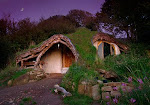Cob is BEAUTIFUL ART that can be made into houses, garden walls, benches, chicken coops, etc. Cob is a mixture of clay, sand, and straw. Your hands and feet are the main tools you need to build with cob. Cob connects people with their artistic side. Cob is earth. Cob is beauty. Cob is sculpting. You don't need to be a builder or architect to build a home with cob. The word cob comes from an old English root meaning a lump or rounded mass. Cobbing is a process best described as mud daubing. Earth, sand and straw are mixed together and massaged onto the foundation, creating thick load-bearing walls. It's like hand-sculpting a giant pot to live in :)
Earthen homes are common in Africa, the Middle East, India, Afghanistan, Asia, Europe, South and Central America. Easily one-third of the world's population is currently living in homes made of unbaked earth.
The three most common forms of earth buildings are adobe, rammed earth and cob. In the southwestern United States, the five hundred year old Taos Pueblo, as well as many homes and churches, are made of adobe. Adobe is a form of building using unfired earth. Dirt, straw and water - the same ingredients as in cob - are made into bricks which are then sun dried and built into walls with a "cob-like" mortar. Some very old Native American structures like the Casa Grande ruin in Arizona are made out of cob. These are described locally as being built of "puddled or coursed adobe".
There is evidence that cob building began in Europe about 800 years ago. Some buildings that were built in the 16th and 17th centuries are still standing today. In England, there are approximately 50,000 cob buildings still in use today. Most of these were constructed in the 18th and 19th centuries.


No comments:
Post a Comment